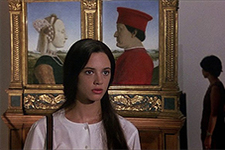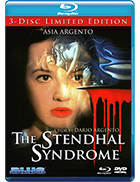The Stendhal Syndrome
|  The Stendhal Syndrome (La sindrome di Stendhal) marked Dario Argento’s return to Italian filmmaking after spending half a decade in the U.S., where he directed two poorly received films, Two Evil Eyes (1991)—a two-part effort based on the works of Edgar Allan Poe, the other half of which was directed by George A. Romero—and Trauma (1993). For his return to his native Italy (the last film he directed there was 1987’s Opera), Argento chose to use the central concept from Italian psychiatrist Graziella Magherini’s 1989 book The Stendhal Syndrome to anchor a murder mystery, thus harkening back to his earliest directorial efforts like The Bird With the Crystal Plumage (1970) and The Cat o’ Nine Tails (1971), which were more traditional giallo devoid of supernatural elements. As he put it, he wanted to make a “high-concept European movie,” and he centered the action in highly visible locations like the Uffizi Gallery and prominent streets in Rome. The plot concerns a homicide detective from Rome named Anna Manni (Asia Argento, the director’s daughter), who we first meet wandering through the Uffizi in an amnesiac haze, eventually succumbing to the titular psychosomatic disorder, which involves people becoming overwhelmed psychologically and physically while in the presence of great works of art. Anna has been tracking a serial rapist/murderer who we soon learn is a disarmingly handsome, well-dressed, seemingly polite man named Alfredo Grossi (Thomas Kretschmann), who decides to make Anna his next victim. However, rather than killing her as he has begun doing with his other victims, he allows her to live, thus placing her in the precarious position of being both hunter and prey, forever looking over her shoulder for the very man she is tracking. Anna begins seeing a psychiatrist (Paolo Bonacelli) at the behest of her captain (Luigi Diberti), but she finds that she is increasingly disconnected from those around her, including her boyfriend, a fellow detective named Marco (Marco Leonardi). In fact, Anna begins to display signs of sadistic and sadomasochistic behavior, which suggests that she has become somehow possessed (psychologically or otherwise) by Alfredo, which Argento beautifully foreshadows early in the film when his reflection merges with her face inside the window of a taxicab. As with most of Argento’s films, The Stendhal Syndome bears traces of both his strengths and his weaknesses. In terms of the former, it is a film of great visual intensity, and Argento uses the titular syndrome as a good excuse to send the camera spinning and whirling; he also employs some fairly clunky digital effects to convey the idea of Anna actually stepping into the paintings that are overwhelming her, an idea whose thematic merits outstrip the limited technologies used to convey it. Working with cinematographer Giuseppe Rotunno (who had previously worked with Luchino Visconti, Federico Fellini, Terry Gilliam, and Bob Fosse, among others), Argento dials back the baroque visual outlandishness that characterized some of his previous films (notably his 1977 masterwork Suspiria), but he still maintains the consistent evocation that the action is taking place somewhere between dreams and reality. The film’s best sequence is arguably its enigmatic opening, which dispenses with dialogue for nearly 10 minutes as we follow Anna, who at this point is a complete mystery of a character, around the Uffizi; it evokes the best of Brian De Palma, particularly the visually similar museum sequence in Dressed to Kill (1980), but it is also uniquely Argento-esque. The film also benefits substantially from a creepy score by composer Ennio Morricone, who by the mid-’90s had already reached legendary status and with whom Argento had collaborated on his first three directorial efforts in the early ’70s. From a story perspective, The Stendhal Syndrome isn’t a masterwork, but it is one of Argento’s stronger efforts, as it never devolves in narrative chaos or comes completely unraveled in terms of reason and logic. It certainly pushes the bounds of the rational, but in a way that feels purposeful, rather than sloppy. There is at best a tenuous relationship between the titular syndrome and the mystery plot involving Anna tracking her own rapist; at times, it feels like Argento is simply shoehorning in the psychological issue to fill in the gaps for the rest of the story or simply because he’s fascinated by it, although Anna’s psychological fragility despite her powerful position as a police detective helps bridge the divide. Argento does go over the top in ways that aren’t particularly useful, such as when he depicts pills going doing Anna’s throat for no apparent reason (here the cheesy-looking digital effects break down the film’s aura), but at other times his tendency to push boundaries really pays off (such as the shot when Alfredo leers at Anna through the ragged bullet hole he just put in another victim’s face). Argento had originally intended to cast Bridget Fonda in the role of Anna and shoot the film in the U.S., but when he moved the production to Italy, he cast his daughter, Asia, who had previously starred in Trauma. Asia is certainly a good actress, and she acquits herself very well in a role that is immensely complicated, even though she looks far too young to be a seasoned police detective (one wonders how the film might have been different and possibly better with an older actress in the role, rather than a 21-year-old who sometimes looks even younger). Anna goes through three dramatic personality changes, each of which is matched by a shifting physical appearance (she is introduced with long dark hair and soft, light colors, shifts to a more masculine appearance with pants and short hair, and finally adopts a Veronica Lake-esque blond wig and dramatic Hollywood sunglasses). The psychological toll of her experiences form the film’s emotional bedrock, and our sympathy with Anna remains strong even when her behavior begins to deviate from the norm in unexpected and unsettling ways. The Argentos—both the director and the actress—don’t hold back in conveying the intensity of sexual violence in both physical and psychological terms, and The Stendhal Syndrome is at its best when it drives us deep into its fractured aftermath.
Copyright © 2017 James Kendrick Thoughts? E-mail James Kendrick All images copyright © Blue Underground | |||||||||||||||||||||||||||||||
Overall Rating: 

 (3)
(3)


